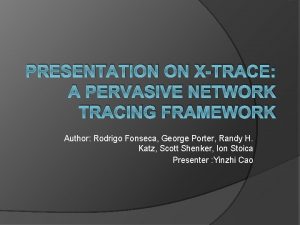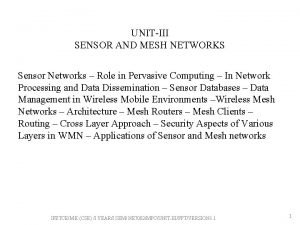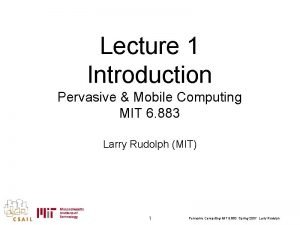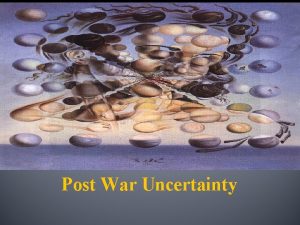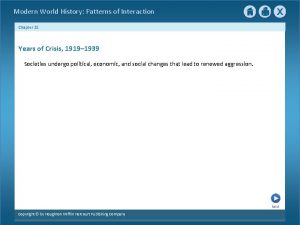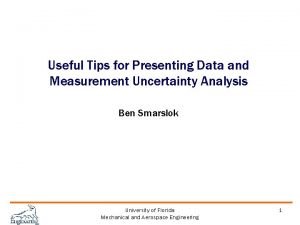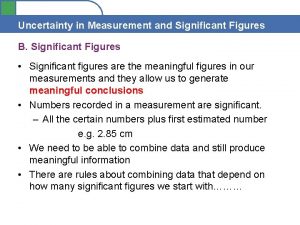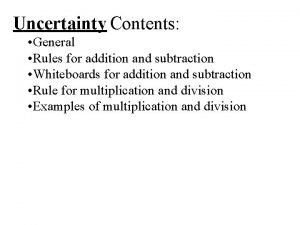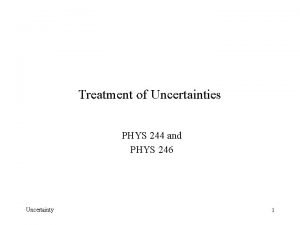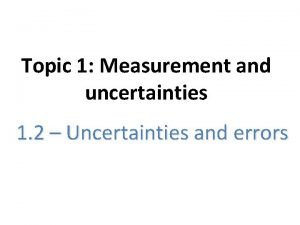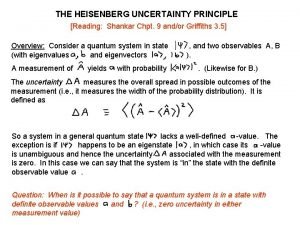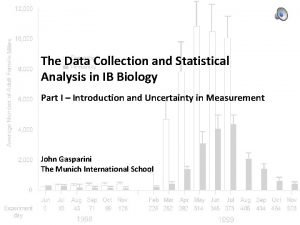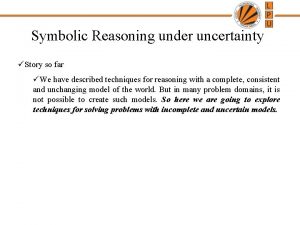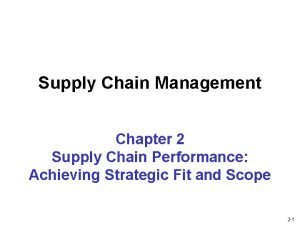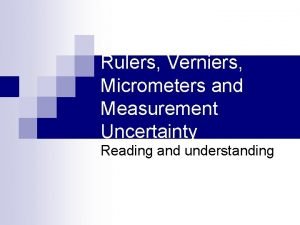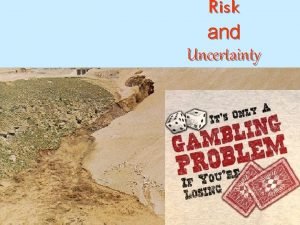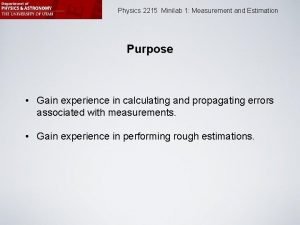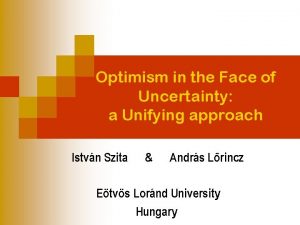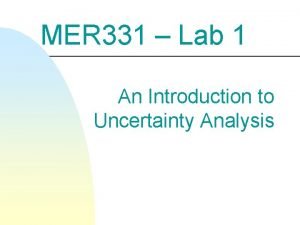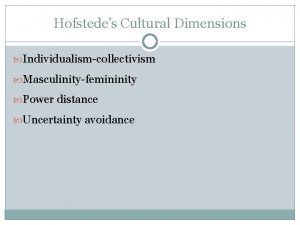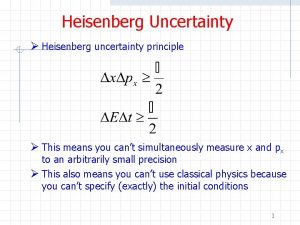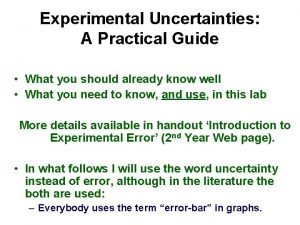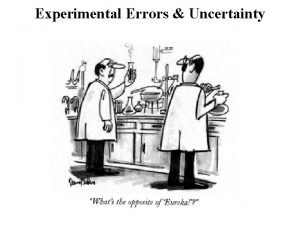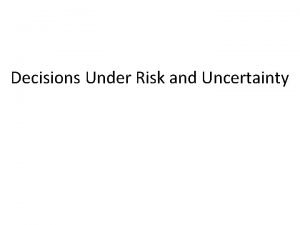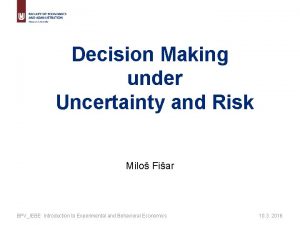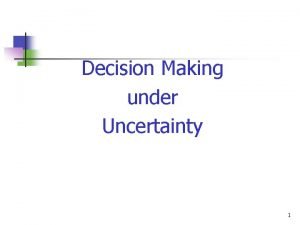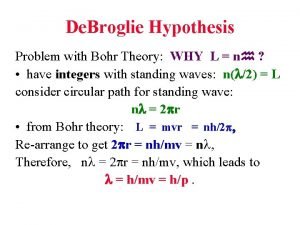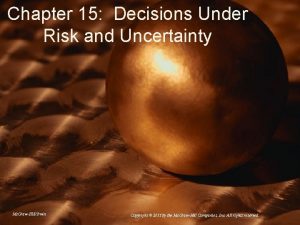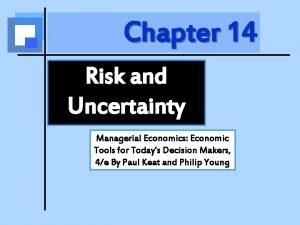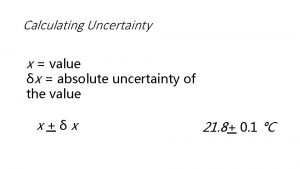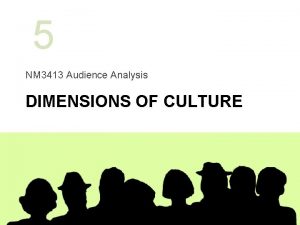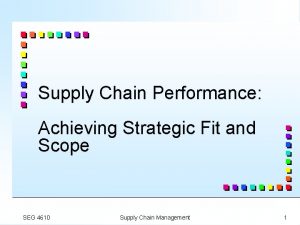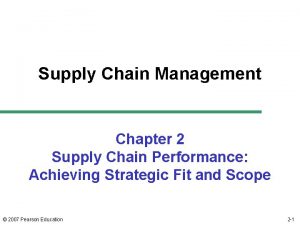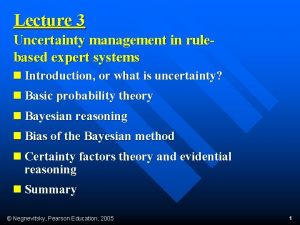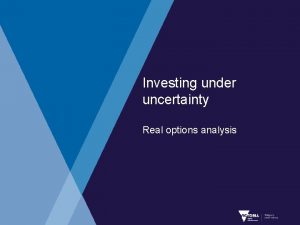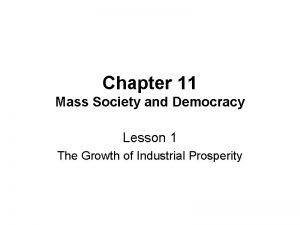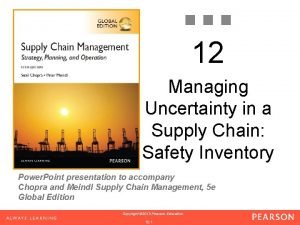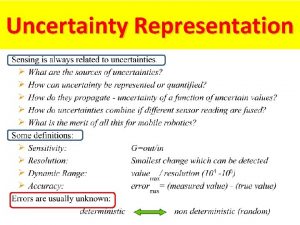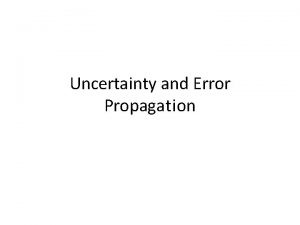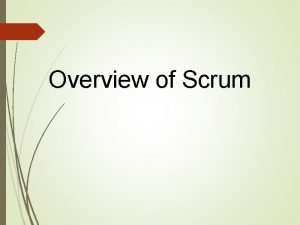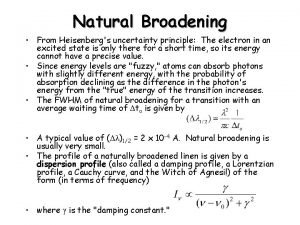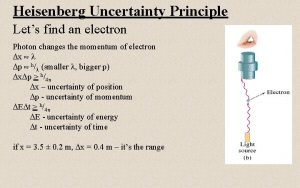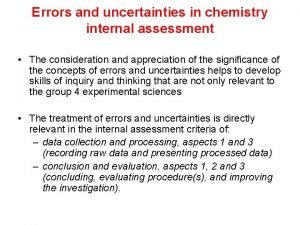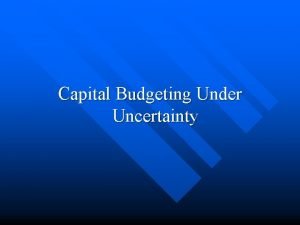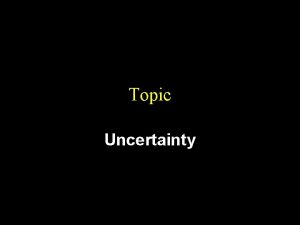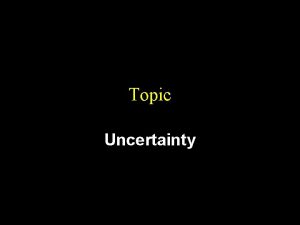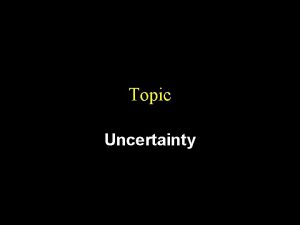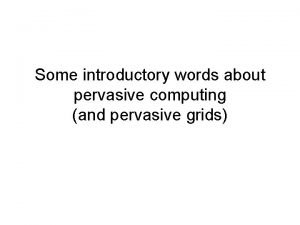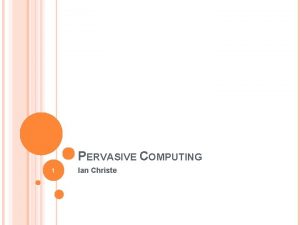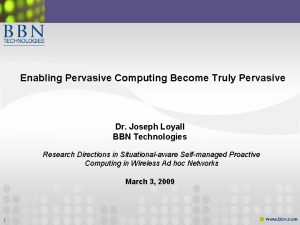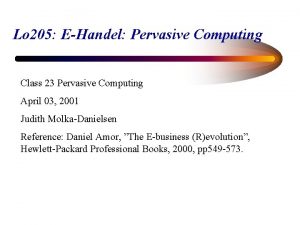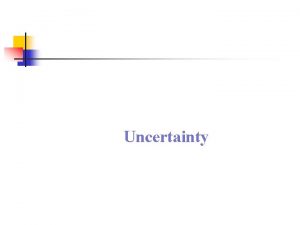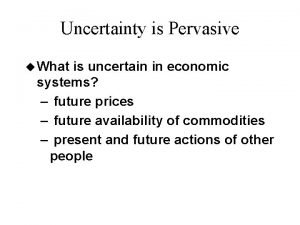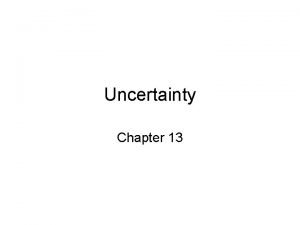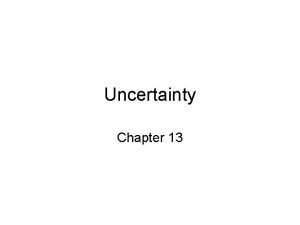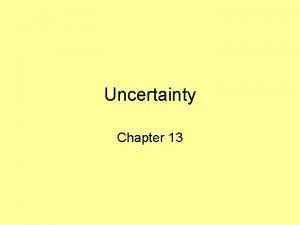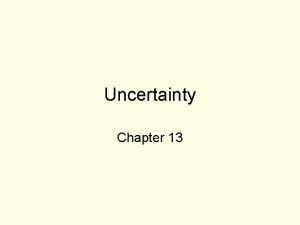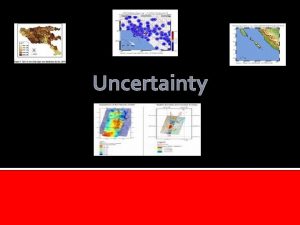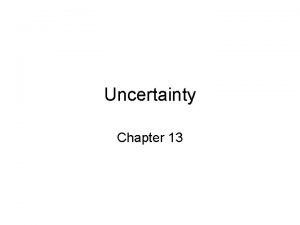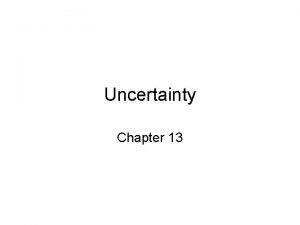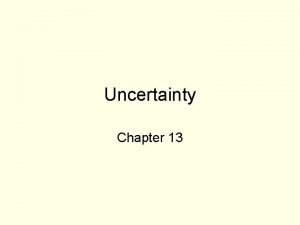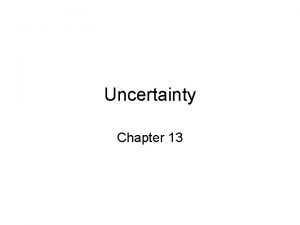Chapter 12 Uncertainty Uncertainty is Pervasive u What








































































- Slides: 72

Chapter 12 Uncertainty

Uncertainty is Pervasive u What is uncertain in economic systems? – tomorrow’s prices – future wealth – future availability of commodities – present and future actions of other people.

Uncertainty is Pervasive u What are rational responses to uncertainty? – buying insurance (health, life, auto) – a portfolio of contingent consumption goods.

States of Nature u Possible states of Nature: – “car accident” (a) – “no car accident” (na). u Accident occurs with probability a, does not with probability na ; a + na = 1. u Accident causes a loss of $L.

Contingencies u. A contract implemented only when a particular state of Nature occurs is state-contingent. u E. g. the insurer pays only if there is an accident.

Contingencies u. A state-contingent consumption plan is implemented only when a particular state of Nature occurs. u E. g. take a vacation only if there is no accident.

State-Contingent Budget Constraints $1 of accident insurance costs . u Consumer has $m of wealth. u Cna is consumption value in the noaccident state. u Ca is consumption value in the accident state. u Each

State-Contingent Budget Constraints Cna Ca

State-Contingent Budget Constraints Cna A state-contingent consumption with $17 consumption value in the accident state and $20 consumption value in the no-accident state. 20 17 Ca

State-Contingent Budget Constraints u Without insurance, u Ca = m - L u Cna = m.

State-Contingent Budget Constraints Cna m The endowment bundle. Ca

State-Contingent Budget Constraints u Buy $K of accident insurance. u Cna = m - K. u Ca = m - L - K + K = m - L + (1 - )K.

State-Contingent Budget Constraints u Buy $K of accident insurance. u Cna = m - K. u Ca = m - L - K + K = m - L + (1 - )K. u So K = (Ca - m + L)/(1 - )

State-Contingent Budget Constraints u Buy $K of accident insurance. u Cna = m - K. u Ca = m - L - K + K = m - L + (1 - )K. u So K = (Ca - m + L)/(1 - ) u And Cna = m - (Ca - m + L)/(1 - )

State-Contingent Budget Constraints u Buy $K of accident insurance. u Cna = m - K. u Ca = m - L - K + K = m - L + (1 - )K. u So K = (Ca - m + L)/(1 - ) u And Cna = m - (Ca - m + L)/(1 - ) u I. e.

State-Contingent Budget Constraints Cna m The endowment bundle. Ca

State-Contingent Budget Constraints Cna m The endowment bundle. Ca

State-Contingent Budget Constraints Cna m The endowment bundle. Where is the most preferred state-contingent consumption plan? Ca

Preferences Under Uncertainty u Think of a lottery. u Win $90 with probability 1/2 and win $0 with probability 1/2. u U($90) = 12, U($0) = 2. u Expected utility is

Preferences Under Uncertainty u Think of a lottery. u Win $90 with probability 1/2 and win $0 with probability 1/2. u U($90) = 12, U($0) = 2. u Expected utility is

Preferences Under Uncertainty u Think of a lottery. u Win $90 with probability 1/2 and win $0 with probability 1/2. u Expected money value of the lottery is

Preferences Under Uncertainty u EU = 7 and EM = $45. u U($45) > 7 $45 for sure is preferred to the lottery risk-aversion. u U($45) < 7 the lottery is preferred to $45 for sure risk-loving. u U($45) = 7 the lottery is preferred equally to $45 for sure riskneutrality.

Preferences Under Uncertainty 12 EU=7 2 $0 $45 $90 Wealth

Preferences Under Uncertainty U($45) > EU risk-aversion. 12 U($45) EU=7 2 $0 $45 $90 Wealth

Preferences Under Uncertainty U($45) > EU risk-aversion. 12 U($45) MU declines as wealth rises. EU=7 2 $0 $45 $90 Wealth

Preferences Under Uncertainty 12 EU=7 2 $0 $45 $90 Wealth

Preferences Under Uncertainty U($45) < EU risk-loving. 12 EU=7 U($45) 2 $0 $45 $90 Wealth

Preferences Under Uncertainty U($45) < EU risk-loving. 12 MU rises as wealth rises. EU=7 U($45) 2 $0 $45 $90 Wealth

Preferences Under Uncertainty 12 EU=7 2 $0 $45 $90 Wealth

Preferences Under Uncertainty U($45) = EU risk-neutrality. 12 U($45)= EU=7 2 $0 $45 $90 Wealth

Preferences Under Uncertainty U($45) = EU risk-neutrality. 12 MU constant as wealth rises. U($45)= EU=7 2 $0 $45 $90 Wealth

Preferences Under Uncertainty u State-contingent consumption plans that give equal expected utility are equally preferred.

Preferences Under Uncertainty Cna Indifference curves EU 1 < EU 2 < EU 3 EU 2 EU 1 Ca

Preferences Under Uncertainty u What is the MRS of an indifference curve? u Get consumption c 1 with prob. 1 and c 2 with prob. 2 ( 1 + 2 = 1). u EU = 1 U(c 1) + 2 U(c 2). u For constant EU, d. EU = 0.

Preferences Under Uncertainty

Preferences Under Uncertainty

Preferences Under Uncertainty

Preferences Under Uncertainty

Preferences Under Uncertainty

Preferences Under Uncertainty Cna Indifference curves EU 1 < EU 2 < EU 3 EU 2 EU 1 Ca

Choice Under Uncertainty u Q: How is a rational choice made under uncertainty? u A: Choose the most preferred affordable state-contingent consumption plan.

State-Contingent Budget Constraints Cna m The endowment bundle. Where is the most preferred state-contingent consumption plan? Ca

State-Contingent Budget Constraints Cna m The endowment bundle. Where is the most preferred state-contingent consumption plan? Affordable plans Ca

State-Contingent Budget Constraints Cna More preferred m Where is the most preferred state-contingent consumption plan? Ca

State-Contingent Budget Constraints Cna Most preferred affordable plan m Ca

State-Contingent Budget Constraints Cna Most preferred affordable plan m Ca

State-Contingent Budget Constraints Cna m Most preferred affordable plan MRS = slope of budget constraint Ca

State-Contingent Budget Constraints Cna m Most preferred affordable plan MRS = slope of budget constraint; i. e. Ca

Competitive Insurance u Suppose entry to the insurance industry is free. u Expected economic profit = 0. u I. e. K - a. K - (1 - a)0 = ( - a)K = 0. u I. e. free entry = a. u If price of $1 insurance = accident probability, then insurance is fair.

Competitive Insurance u When insurance is fair, rational insurance choices satisfy

Competitive Insurance u When insurance is fair, rational insurance choices satisfy u I. e.

Competitive Insurance u When insurance is fair, rational insurance choices satisfy u I. e. u Marginal utility of income must be the same in both states.

Competitive Insurance u How much fair insurance does a riskaverse consumer buy?

Competitive Insurance u How much fair insurance does a riskaverse consumer buy? u Risk-aversion MU(c) as c .

Competitive Insurance u How much fair insurance does a riskaverse consumer buy? u Risk-aversion u Hence MU(c) as c .

Competitive Insurance u How much fair insurance does a riskaverse consumer buy? u Risk-aversion MU(c) as c . u Hence u I. e. full-insurance.

“Unfair” Insurance u Suppose insurers make positive expected economic profit. u I. e. K - a. K - (1 - a)0 = ( - a)K > 0.

“Unfair” Insurance u Suppose insurers make positive expected economic profit. u I. e. K - a. K - (1 - a)0 = ( - a)K > 0. u Then > a

“Unfair” Insurance u Rational choice requires

“Unfair” Insurance u Rational u Since choice requires

“Unfair” Insurance u Rational choice requires u Since u Hence for a risk-averter.

“Unfair” Insurance u Rational choice requires u Since u Hence for a risk-averter. u I. e. a risk-averter buys less than full “unfair” insurance.

Uncertainty is Pervasive u What are rational responses to uncertainty? – buying insurance (health, life, auto) – a portfolio of contingent consumption goods.

Uncertainty is Pervasive u What are rational responses to uncertainty? – buying insurance (health, life, auto) – a portfolio of contingent consumption goods.

Uncertainty is Pervasive u What are rational responses to uncertainty? – buying insurance (health, life, auto) ? – a portfolio of contingent consumption goods.

Diversification u Two firms, A and B. Shares cost $10. u With prob. 1/2 A’s profit is $100 and B’s profit is $20. u With prob. 1/2 A’s profit is $20 and B’s profit is $100. u You have $100 to invest. How?

Diversification u Buy only firm A’s stock? u $100/10 = 10 shares. u You earn $1000 with prob. 1/2 and $200 with prob. 1/2. u Expected earning: $500 + $100 = $600

Diversification u Buy only firm B’s stock? u $100/10 = 10 shares. u You earn $1000 with prob. 1/2 and $200 with prob. 1/2. u Expected earning: $500 + $100 = $600

Diversification u Buy 5 shares in each firm? u You earn $600 for sure. u Diversification has maintained expected earning and lowered risk.

Diversification u Buy 5 shares in each firm? u You earn $600 for sure. u Diversification has maintained expected earning and lowered risk. u Typically, diversification lowers expected earnings in exchange for lowered risk.

Risk Spreading/Mutual Insurance u 100 risk-neutral persons each independently risk a $10, 000 loss. u Loss probability = 0. 01. u Initial wealth is $40, 000. u No insurance: expected wealth is

Risk Spreading/Mutual Insurance u Mutual insurance: Expected loss is u Each of the 100 persons pays $1 into a mutual insurance fund. u Mutual insurance: expected wealth is u Risk-spreading benefits everyone.
 Image trace makes white box
Image trace makes white box Orchastrate
Orchastrate Primary and secondary stakeholders
Primary and secondary stakeholders Mobile computer wikipedia
Mobile computer wikipedia Pddst
Pddst Pervasive and mobile computing
Pervasive and mobile computing Pervasive computing ppt
Pervasive computing ppt Mobile and pervasive computing
Mobile and pervasive computing Pervasive developmental disorder
Pervasive developmental disorder Pervasive and mobile computing
Pervasive and mobile computing Melancholic features
Melancholic features Postwar uncertainty
Postwar uncertainty Chapter 15 section 2 world history
Chapter 15 section 2 world history Random uncertainty
Random uncertainty Certain vs uncertain digits
Certain vs uncertain digits Significant figures cartoon
Significant figures cartoon Uncertainty in addition
Uncertainty in addition Error propagation multiplication
Error propagation multiplication Uncertainties higher physics
Uncertainties higher physics Calculating percent difference
Calculating percent difference Absolute uncertainty formula
Absolute uncertainty formula Heisenberg uncertainty principle mathematically
Heisenberg uncertainty principle mathematically Triple beam balance uncertainty
Triple beam balance uncertainty Minimalist reasoning
Minimalist reasoning Supply chain performance achieving strategic fit and scope
Supply chain performance achieving strategic fit and scope Pearson uncertainty map
Pearson uncertainty map Absinch
Absinch Risk and uncertainty continuum
Risk and uncertainty continuum Restate your position
Restate your position Heisenberg uncertainty principle statement
Heisenberg uncertainty principle statement Propagating uncertainty physics
Propagating uncertainty physics Slack
Slack Optimism in the face of uncertainty
Optimism in the face of uncertainty Maxwell equation tattoo
Maxwell equation tattoo Design stage uncertainty
Design stage uncertainty Error propagation equation
Error propagation equation Express uncertainty
Express uncertainty Low power distance คือ
Low power distance คือ Heisenberg uncertainty principle
Heisenberg uncertainty principle Uncertainty formula
Uncertainty formula Experimental errors and uncertainty
Experimental errors and uncertainty How do you do percent error
How do you do percent error Difference between risk and uncertainty
Difference between risk and uncertainty Decision-making under uncertainty
Decision-making under uncertainty Decision-making under uncertainty
Decision-making under uncertainty Heisenberg uncertainty principle statement
Heisenberg uncertainty principle statement Relative uncertainty formula
Relative uncertainty formula Equity theory communication
Equity theory communication Heisenberg uncertainty principle states that
Heisenberg uncertainty principle states that Uncertainty vs risk
Uncertainty vs risk Risk and uncertainty in managerial economics
Risk and uncertainty in managerial economics Absolute uncertainty equation
Absolute uncertainty equation Laray m. barna (1997)
Laray m. barna (1997) Strategic fit
Strategic fit Implied uncertainty spectrum
Implied uncertainty spectrum Uncertainty of thermometer
Uncertainty of thermometer Uncertainty management in rule-based expert systems
Uncertainty management in rule-based expert systems Heisenberg jokes
Heisenberg jokes Risk versus uncertainty
Risk versus uncertainty Language
Language Systems engineering with uncertainty
Systems engineering with uncertainty Mass society and democracy lesson 1
Mass society and democracy lesson 1 Expected shortage per replenishment cycle
Expected shortage per replenishment cycle Gaussian standard deviation
Gaussian standard deviation Uncertainty orientation
Uncertainty orientation Propagated
Propagated Scientific measurements
Scientific measurements Ketidakpastian dan peluang
Ketidakpastian dan peluang Scrum agenda
Scrum agenda Doppler broadening
Doppler broadening Photon uncertainty principle
Photon uncertainty principle Are trailing zeros significant
Are trailing zeros significant Capital budgeting under risk and uncertainty
Capital budgeting under risk and uncertainty
